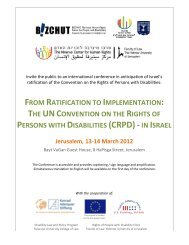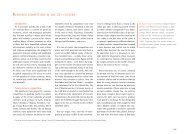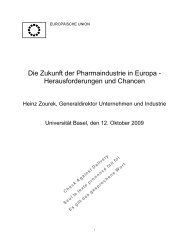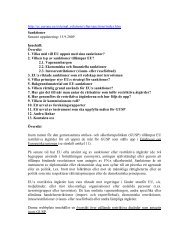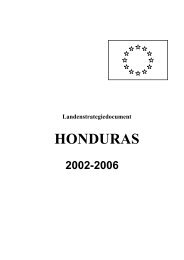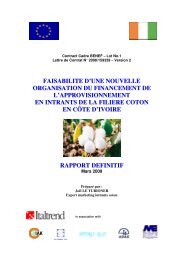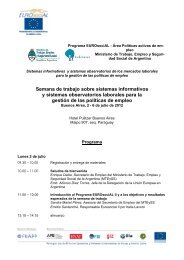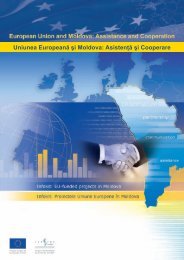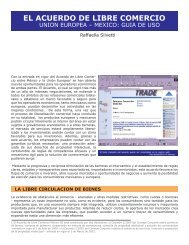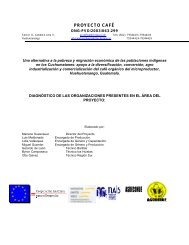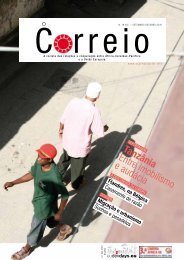Regional Reports - the European External Action Service
Regional Reports - the European External Action Service
Regional Reports - the European External Action Service
Create successful ePaper yourself
Turn your PDF publications into a flip-book with our unique Google optimized e-Paper software.
� Opportunities for learning on aspects of organizational development; including governance,<br />
constituency streng<strong>the</strong>ning, resource mobilization; accountability are not available for <strong>the</strong><br />
majority of NSAs,<br />
Facilities<br />
� Some NSA having <strong>the</strong>ir office facilities made available by <strong>the</strong> City Administration- Iddirs,<br />
Women Association and Youth Association, Youth and Anti-Aids Clubs<br />
� Most of <strong>the</strong> local organisations are operating from rented facilities<br />
� Some NSA do not have <strong>the</strong>ir own office and are hosted in shared facilities with commercial<br />
activities or o<strong>the</strong>r CSOs.<br />
21. Capacity Building Needs<br />
The overall capacity is highly limited by <strong>the</strong> resource gap, so most of <strong>the</strong> organisations highlight<br />
that to build <strong>the</strong>ir capacity <strong>the</strong>y need to be reinforced in terms of materials, financial and technical<br />
resources.<br />
The low level of resource mobilisation from <strong>the</strong> members and <strong>the</strong> communities is a constraint,<br />
due to <strong>the</strong> fact that <strong>the</strong>se constituencies belong to <strong>the</strong> most disadvantaged layers of <strong>the</strong> population,<br />
but <strong>the</strong> issue can be considered also in terms of capacity for income generation (marketable<br />
services, sponsorships, capacity for generating credible project proposal for funding by <strong>the</strong><br />
international partners).<br />
The second issue is <strong>the</strong> lack of skilled manpower for service delivery and technical issues.<br />
The third issue is related to Organisational Development, organisational management and<br />
leadership and also on administration.<br />
The merging process which has involved some CBOs has generated a positive attitude towards<br />
<strong>the</strong> creation of bigger scale organisations and capacity for networking and resource-sharing is<br />
ano<strong>the</strong>r important field where capacity has to be built or streng<strong>the</strong>ned.<br />
A very important gap is found in Project Cycle Management because <strong>the</strong> Organisations complain<br />
about <strong>the</strong>ir capacity to access <strong>the</strong> funding by International Partners due to <strong>the</strong>ir low level of<br />
project design, implementation, monitoring and administration.<br />
5. <strong>Regional</strong> Report Oromia<br />
1. General remarks on NSA at territorial level<br />
1.1. Background about Oromia NRS<br />
Oromia National <strong>Regional</strong> State (ONRS) is <strong>the</strong> largest of all <strong>the</strong> nine regions in terms of both<br />
population and geographic area. The total area of <strong>the</strong> regions about 30 percent of <strong>the</strong> entire<br />
country and its total population is estimated to be over 30 million. Geographically, ONRS is<br />
located at <strong>the</strong> centre of <strong>the</strong> country engulfing <strong>the</strong> nation’s capital, Addis Ababa at its heart and<br />
stretches fur<strong>the</strong>r to <strong>the</strong> West, East and also extends to <strong>the</strong> most Sou<strong>the</strong>rn part of <strong>the</strong> country where<br />
it shares border with Kenya.<br />
In terms of its agro-ecology, <strong>the</strong> ONRS combines highland, med-altitude and lowland ecological<br />
zones. The major proportion of <strong>the</strong> region falls into <strong>the</strong> first two zones which have enormous<br />
agricultural potential and conductive wea<strong>the</strong>r condition suitable for farming and livestock<br />
husbandry. Most of <strong>the</strong> region’s population also lives in <strong>the</strong>se areas because of <strong>the</strong> natural<br />
condition and a relatively more developed infrastructure like road network and commercialization<br />
63




